The document discusses the optimization of process parameters for convective-cum-microwave dehydration of garlic slices using a response surface methodology approach. It details the effects of varying KMS concentration, drying air temperature, and microwave power levels on the quality attributes and energy consumption of garlic drying. The optimal conditions identified were a KMS concentration of 0.5%, a drying air temperature of 59.41°C, and a microwave power level of 810W, achieving reduced drying time and improved quality metrics.
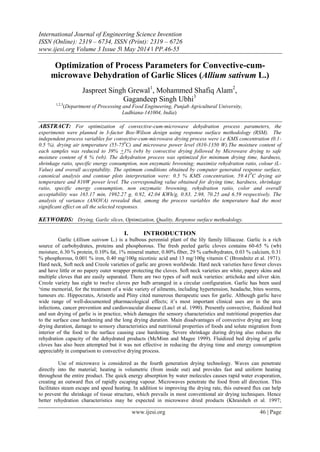

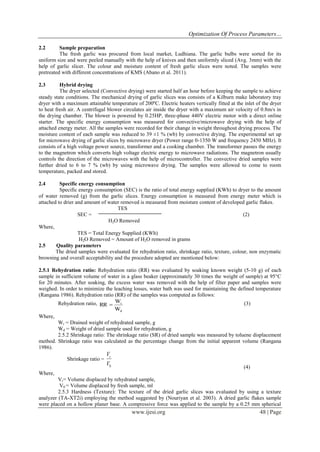


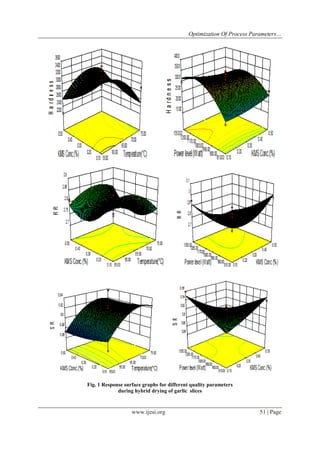
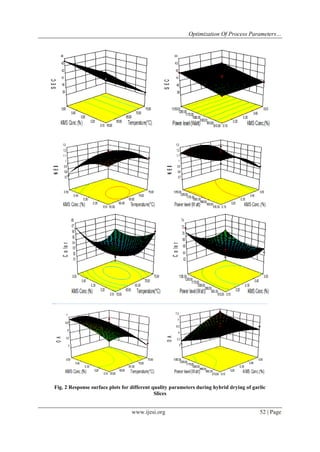
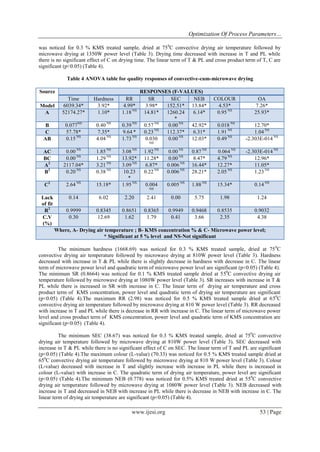

![Optimization Of Process Parameters…
www.ijesi.org 55 | Page
REFERENCES
[1] Abano E E and Qu W (2011) Effects of Pretreatments on the Drying Characteristics and Chemical Composition of Garlic Slices in
a Convective Hot Air Dryer. J Agric Fd Technol 5:50-58.
[2] Ade O, Rastogi N K, Angersbach A and Knorr D (2002) Osmotic dehydration behavior of red paprika (Capsicum annum L.) J Fd
Sci 67:1790-96.
[3] Alam M S, Singh A and Sawhney B K (2010) Response surface optimization of osmotic dehydration process for aonla slices. J Fd
Sci Technol 47: 47-54
[4] Box G E, Behnken D W (1960) Some new three levels designs for the study of quantitative variables. Technometrics 2:455-75.
[5] Brondnitz M H, Pascale J U and Van D L (1971) Flavour component of garlic extract. J Agric Fd Chem 19:273-75.
[6] Dhingra D and Paul S (2005) Optimization of drying conditions of garlic slices. J Fd Sci Technol 42:348–52.
[7] Hunter S (1975) The measurement of appearance. John Wiley and Sons, New York. Pp 304-5.
[8] Khraisheh M A M, Cooper T J R and Magee T R A (1997) Shrinkage characteristic of potatoes dehydrated under combined
microwave and convective air conditions. Drying Technol Int 15:1003-22.
[9] Laul H S, Padma M S and Tosk J M (1990) Allium sativum (Garlic) and cancer prevention. J Nutr Res 10:937:48.
[10] McMinn W M A and Magee T R A (1999) Principles, methods and applications of the convective drying of foodstuffs. Fd Bioprod
Proc 77:175-93.
[11] Montgomery D C (2004) Designs and analysis of experiments. John Wiley & Sons, New York.
[12] Nourian F, Ramaswamy H S and Kushalappa (2003) Kinetic changes in cooking quality of potatoes stored at different
temperatures. J Fd Engg 60:257-266
[13] Prabhanjan D G Ramaswamy H S and Raghavan, G S V (1995) Microwave- assisted convective air drying of thin layer carrots. J Fd
Engg 25:283-93.
[14] Ranganna S (1986) Handbook of analysis and quality control for fruits and vegetable products. 2nd
edition, pp 171-74. Tata McGraw
Hill publishing company Ltd. New Delhi, India.
[15] Themelin A, Raoult W A L, Lebert A and Danzart M (1997) Multicriteria optimization of food processing combining soaking prior
to air drying. Drying Technol 15:2263-79.](https://image.slidesharecdn.com/g0354046055-140531020943-phpapp02/85/G0354046055-10-320.jpg)